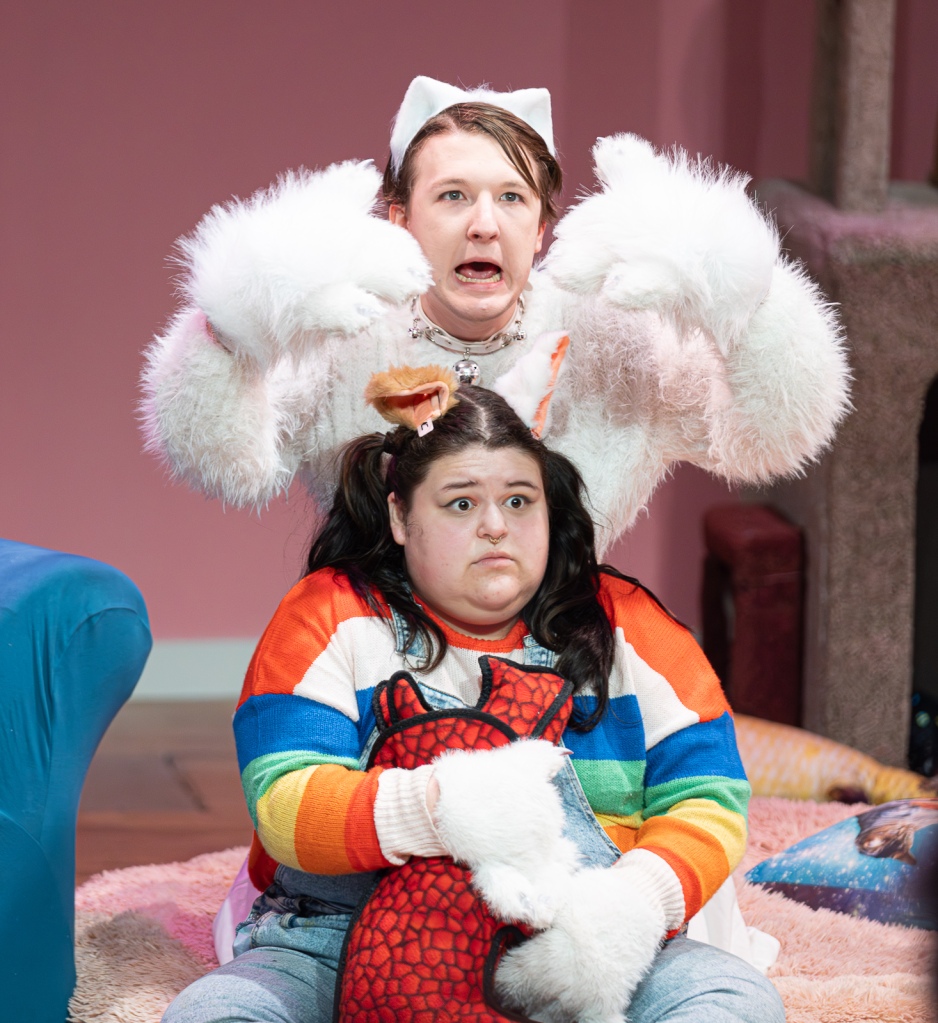
reviewed by Daniel Shock
Amid the chaos of our morning preparations for a road trip to Chattanooga, our cat decided to make a statement by throwing up in our open suitcase. This incident left us half-amused, half-frustrated, and fully convinced it was a calculated act. This moment coincided with my need to gather my thoughts about the unpredictable charm and occasional mayhem pets bring into our lives for this review of Theatre Unchained’s production of Neil Martin’s Herding Cats. Unlike our little saboteur, the feline characters in Herding Cats may not resort to villainy, but they certainly weave their own unique brand of mischief into their owner’s life.
Herding Cats tells the tale of several cats: Stella (Angela Dill), Buddha (Julien Lyons), and Lupin (Aspen Harnishfeger), along with their animal-loving owner, human Kelly (Jenny Williams). Their easy life is disrupted when Jenny unexpectedly brings home a (gasp!) dog (Hannah Hoffman) named Charlize to foster. As the cats get to know and negotiate territory, they listen in on Kelly’s phone conversations, which reveal problems with her employer. Fearing the loss of the loving home they know, they join forces to try and help Kelly keep her job.
The cast has a great time taking on the personas of their animals. Any pet owner will recognize the behaviors and personality traits displayed here with great comic effect. Angela Dill, as the kitty Stella, is wonderfully funny and has mastered quite an array of cat sounds. Julien Lyons, as Buddha—the Dr. Frasier Crane of cats and Stella’s brother—is hysterical and has some of the very best snooty cat material to work with. Completing the trio, Aspen Harnishfeger plays Lupin, a ‘street cat’ with charm and swagger. All three cats have great moments and keep the audience in stitches. Hannah Hoffman plays the sweet newcomer, Charlize the pit bull, with an earnest joy that makes you want to scratch her ears and ask, “Who’s a good girl?” Pet owner Kelly the human is played by real-life human, Jenny Williams, with natural authenticity, perfectly capturing a young adult navigating the stresses of life and the joy of pet ownership.
Megan Ann Jacobs, the director, costumer, and sound designer, has put together a funny and charming show. I don’t always mention costumes in my reviews, as some shows depend on them more than others. However, the costumes by Ms. Jacobs wonderfully bring out the personalities of the animals with ears, paws, and tails. My favorite has to be Buddha’s all-white fuzzy outfit that really highlights his snooty prince persona. The set by Kurt Watkins is also fantastic and whimsical, with giant-sized cat towers, beds, and toys.
Overall, the show is a winner and an audience pleaser for animal lovers of all ages. The one negative aspect of the show is its length. It’s possible that there were some behind-the-scenes issues that caused the show to run long when I saw it on Friday night. It did start a bit late. I took my seat at 7:25 (start time was supposed to be 7:30), and the lights came up at 10:27. I mostly place responsibility for the length on the script. A lot of the first act felt redundant, and a few cuts could tighten it up and move things along at a better pace. The audience didn’t seem to mind the length, loudly laughing, hooting, and hollering through the whole show up until the end. But, you might need to take the run time into account when you are paying for parking on Mass. Ave.
Herding Cats runs at the IndyFringe – Basile Theatre at 719 E. St. Clair St., Indianapolis – Saturday and Sunday, March 23rd at 7:30 pm and 24th at 3:00 pm. And then next weekend, Thursday, March 28th at 7:30, Friday, March 29th at 7:30, and Saturday, March 30th at 7:30. Tickets are available online by clicking HERE https://indyfringe.org/performance/2024-unchained-herding-cats/ or at the door.
- photos by Rob Slaven – Indy Ghost Light Photography

































